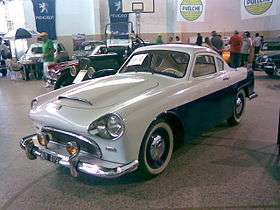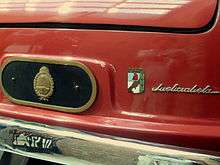IAME Justicialista
The Institec Justicialista was a line of cars produced by the government of Argentina through its IAME (Industrias Aeronáuticas y Mecánicas del Estado) from 1954 to 1955 as an early attempt to form an Argentine automotive industry. It used a front engine front wheel drive layout with a two-stroke two-cylinder engine derived from a German DKW design,[1] and a conventional metal body. Due to the insistence of General Peron to have a sports car version made,[2] a fiberglass two seat version was available as a coupe or roadster and featured a 1.5 liter air-cooled Porsche flat-four and a Porsche four-speed gearbox driving the front wheels.[3] When General Peron was overthrown in 1955, the project was abandoned leading to the gradual disappearance of the Justicialista. It was later briefly revived as the short lived Wartburg powered Graciela. Overall, the line was sparingly produced and had few sales but was considered important because of its symbolic value to Argentina.[4]
| Institec Justicialista | |
|---|---|
 | |
| Overview | |
| Manufacturer | IAME (Industrias Aeronáutica y Mecánicas del Estado) |
| Production | 1953–1955 |
| Assembly | Córdoba, Argentina |
| Body and chassis | |
| Related | Rastrojero Rastrojero Conosur |
Pre-production

Through a decree dated 30 November 1949 and signed by the President of the Argentine Nation, Juan Domingo Perón, took charge of the factory processing of IAME Navy aircraft. In 1953, Brigadier Juan Ignacio San Martin, head of the Aviation Industry and State Mechanical IAME, proposed to President Juan Domingo Perón automobile manufacturing. This metalworking facilities to take advantage of IAME.
In order to shorten development times, a rural DKW was imported and its technology was adapted. The original DKW two-cylinder engine had low power and was insufficient for the sedan. Then Magellan Raúl proposed a two-stroke engine but with a "V" type engine, the solution used in their Austrian factory Puch engines of 125 and 250 cc displacement.
Magellan's engine was completely original but with four cylinders, two combustion chambers and a displacement of 800 cc, it was called the M-800.
The bodywork was inspired by the 51 Chevrolet and the IAME aeronautical designers gave their particular image.
For sports cars, a brand-new technology was applied. Reinforced plastic (polyester) fiber glass, to lower the weight. After several prototypes were developed, a hardtop version 2+2 was released, of which 167 units were manufactured before ending production.
Like other domestically produced cars, the Justicialista was made available to the middle and working class.[4] Its production took place in the IAME's complex in the city of Cordoba. The assembly lines were manned by workers who had military in addition to technical training. The managers, themselves, employed military management approach, which rendered the factories as extensions of the barracks.[4]
Models
- Justicialista gran turismo
- Justicialista gran sport
- Justicialista van (Wartburg van)
- Justicialista truck
- Justicialista Wartburg (Wartburg Graciela sedan)
- Justicialista 800 Sedan (M800 engine)
- Rastrojero pickup truck (over 50,000 produced between 1952 and 1979).
- Gauchita Rural Rural Gauchita
Sport is also a closed constructed prototype of the series, and during the military coup was on display at the Paris Motor Show and never returned to the country.
End of Production
In the nearly two years of manufacture, 2300 cars were produced between the Chatito, the vans, and the sedans. It is difficult to identify the breakdown of this figure. However, there are sources that were able to determine the number of manufactured vehicles for some models. For example, it was found that the 1954 IAME Justicialista had a production run of 200 cars and they were built in 1954 until 1955.[5]
The new leadership imposed by the de facto national government gave the assembly plant to the national car distributor Porsche and was renamed Teramo. The Justicialista was changed: the engine was put in the back, changing the tube to resemble the Porsche, and was named Puntero.
Technical
Engine
- four cylinders of 56 x 48 running on two-stroke cycle
- 800 cc
- 4500 rpm power 36 hp at 4500 rpm
- 6,5:1 compression
- carburetor solex
- AC44 plugs
- water-cooled
Transmission
- Multiple disc clutch in oil bath
- gearbox front three-speed propulsion
- helical gear differential
- floating-axis means
Chassis
- Chassis with rails for built in welded sheet drawer
- independent front suspension with transverse leaf spring and hairpin oscillating
- independent rear suspension with torsion bar cross laminated with eight sheets of 5 mm thick
- double action telescopic shock absorbers
- hydraulic foot brake and mechanical hand
- 3,25 x 16 disc wheel with pressed steel wheels 3.25 x 16
- 5,00 x 16 tires 5.00 x 16
- direction zipper
Measurements
- 2400 mm wheelbase
- 1200 mm gauge front
- 1250 mm gauge Back
- Total length 4295 mm
- radio address 5 m
- 200 mm minimum above the floor light
- empty weight 850 kg
- 35 L tank capacity 35 L
- 100 km Naphtha consumption 7.8 L per 100 km
- top speed 120 km/h
See also
- IAME (Industrias Aeronáutica y Mecánicas del Estado)
- Rastrojero
- List of cars manufactured in Argentina
- Lists of automobiles
- List of automobile manufacturers
References
- A to Z of sports cars, 1945–1990 By Mike Lawrence
- EMI Institec Gran Sport (Peronist), Argentina Spanish magazine article dated September 25, 2008, translated March 16, 2010
- Michael Sedgwick. The Motor car 1946-56. p. 264. ISBN 0-7134-1271-2.
The Grand Sport of 1953 was a flashy glassfibre roadster in which a 1,488-cc flat-four Porsche engine was arranged to drive the front wheels. Also of Porsche make was the four-speed all-synchromesh gearbox with overdrive top
- Brennan, James (1994). The Labor Wars in Cordoba, 1955-1976: Ideology, Work, and Labor Politics in an Argentine Industrial Society. Cambridge, MA: Harvard University Press. p. 28. ISBN 0674508513.
- "FWD Argentinian 356: 1954 IAME Justicialista Project". The best vintage and classic cars for sale online | Bring a Trailer. 2015-03-23. Retrieved 2018-07-09.